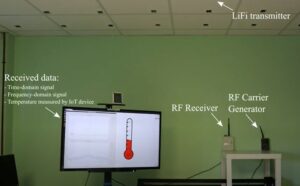IMDEA Networks

"Green light for the Earth": IMDEA Networks at Science and Innovation Week 2020
An online appointment with sustainable technology in the great scientific event organized by madrid+d (Community of Madrid)
12 November 2020
Battery disposal causes harm to the environment, and, as the number of IoT grows, replacing the battery of each IoT device on earth is not viable anymore. The scientific community is recently seeking to design networks that don’t need any battery to communicate as a solution to this problem. IMDEA Networks is actively engaged in this area, and the team consisting of Domenico Giustiniano (Research Associate Professor), Borja Genovés Guzmán (Post-doc Researcher) and Muhammad Sarmad Shahab Mir (PhD Student) from IMDEA Networks, together with Ambuj Varshney (Post-doc Researcher) from University of California, Berkeley, have designed the first prototype of battery-free IoT device that leverages the advantages of two cutting-edge technologies: LiFi and RF backscatter. The researchers of IMDEA Networks Institute have presented the system in the Week of Science and Innovation 2020 with an event titled “Green Light for the Earth”.
 Our researchers demonstrated that the creation of sustainable technology is possible. The system uses LiFi to communicate to the battery-free IoT device. Light emitting diodes (LEDs) used in LiFi are energy efficient emitters in the visible light spectrum. The researchers have explained that, with LiFi, we can both illuminate and transmit data, saving energy. Second, we can capture and store the energy emitted by LiFi in the IoT devices. This energy is orders of magnitude higher than the one that could be collected with Radio Frequency (RF) sources. The prototype avoids the use of batteries by incorporating a small solar cell for harvesting energy and receiving data through LiFi. Furthermore, to decrease the energy consumption, the IoT device transmits data by RF backscattering. Passive RF uses 1000 times less power than conventional active RF transmission. This solution also allows to reduce space and cost which helps to miniaturize the device.
Our researchers demonstrated that the creation of sustainable technology is possible. The system uses LiFi to communicate to the battery-free IoT device. Light emitting diodes (LEDs) used in LiFi are energy efficient emitters in the visible light spectrum. The researchers have explained that, with LiFi, we can both illuminate and transmit data, saving energy. Second, we can capture and store the energy emitted by LiFi in the IoT devices. This energy is orders of magnitude higher than the one that could be collected with Radio Frequency (RF) sources. The prototype avoids the use of batteries by incorporating a small solar cell for harvesting energy and receiving data through LiFi. Furthermore, to decrease the energy consumption, the IoT device transmits data by RF backscattering. Passive RF uses 1000 times less power than conventional active RF transmission. This solution also allows to reduce space and cost which helps to miniaturize the device.
The demo was shown lively and it was demonstrated that the IoT device receives a request from the network to send data it senses (in the demo, the temperature was measured by the IoT device), and it transmits this data to a central station successfully, just using energy stored with indoor lighting. Considering the questions from the audience, this device can be applied for home automation and greenhouses, tracking and measuring environment parameters remotely.
A preliminary version of the work was published earlier this year at the prestigious ACM Mobisys 2020 conference. You can follow up further results of the project in the www.enlightem.eu website and the social media.


Recent Comments